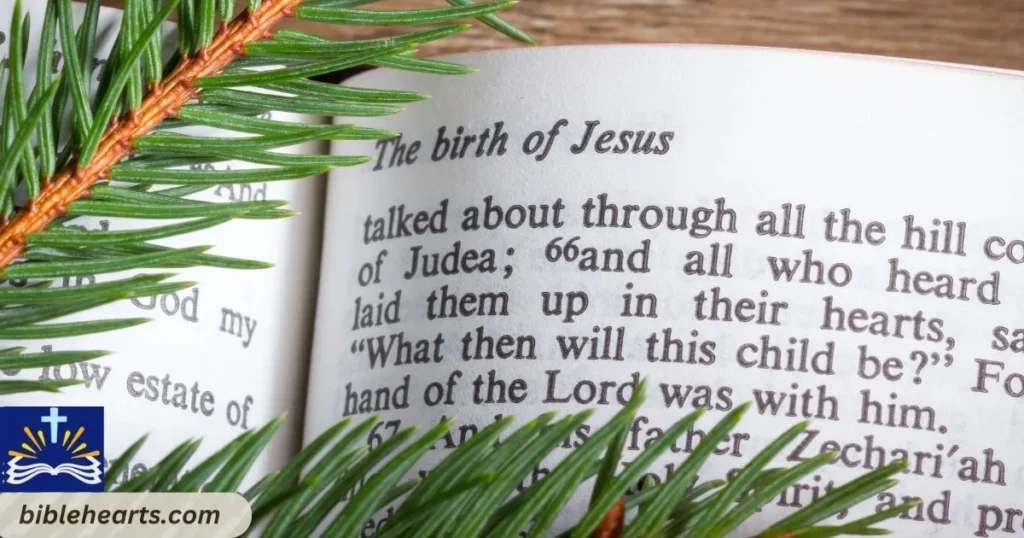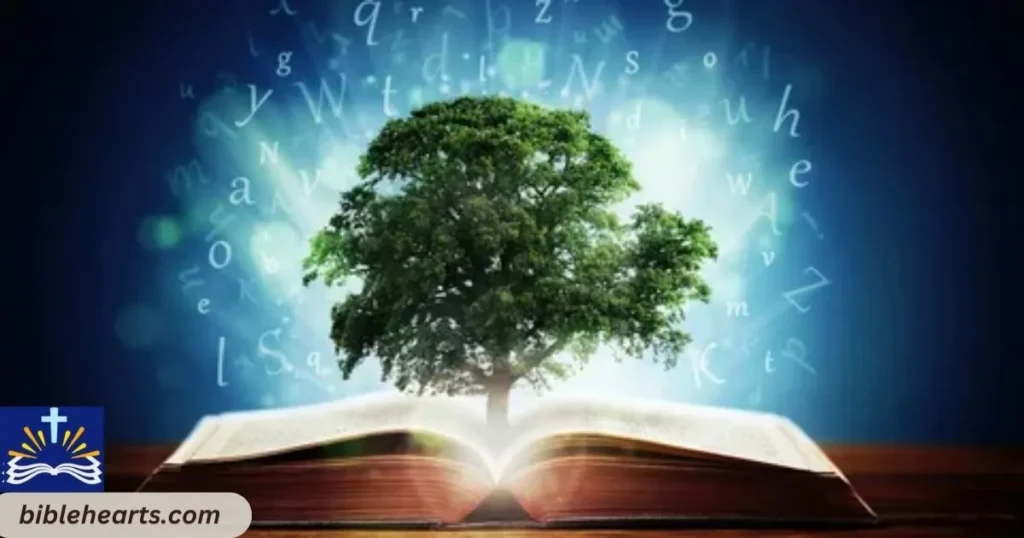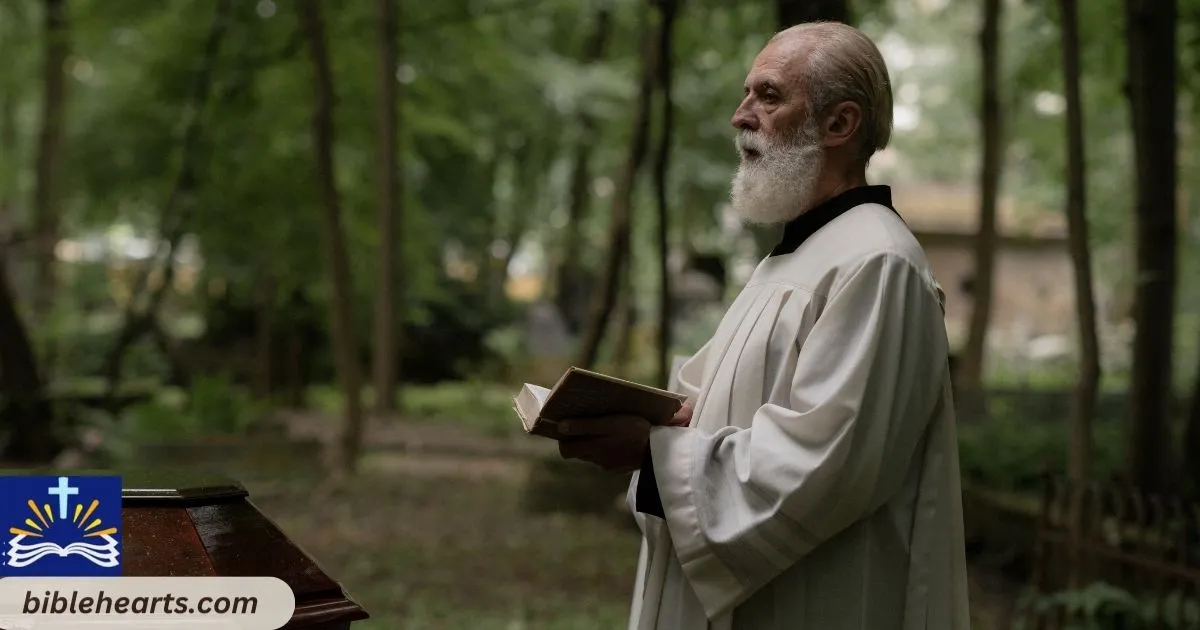“The Bible uses trees to symbolize strength, growth, and the beauty of God’s creation.”
Trees have always been a significant part of life, not just in the physical world, but also in spiritual and biblical contexts. In the Bible, trees are mentioned more than 200 times and often symbolize spiritual growth, faith, and the connection between humanity and God. From the Garden of Eden to the symbolism of the tree of life, the Bible uses these powerful symbols to convey profound messages about life and faith.
The importance of trees in biblical scripture is both literal and metaphorical. The tree is used to illustrate the growth of faith, the rewards of living a righteous life, and the promises of God. In many passages, trees stand as symbols of God’s abundant blessings and protection. Each mention provides insight into deeper spiritual meanings and helps readers understand the teachings in the scripture.
This post delves into some of the most powerful Bible verses about trees. We’ll explore their meanings, how they tie into the broader themes of growth and faith, and what these verses can teach us today. Understanding these verses can help us strengthen our relationship with God and find encouragement in life’s challenges.
Top Bible Verses About Trees
Genesis 2:9
“And out of the ground made the Lord God to grow every tree that is pleasant to the sight, and good for food; the tree of life also in the midst of the garden, and the tree of knowledge of good and evil.”
This verse from Genesis introduces the Tree of Life, a symbol of eternal life, and the Tree of Knowledge of Good and Evil, which represents choices and the consequences of disobedience. In the Garden of Eden, God provided everything Adam and Eve needed, but their decision to eat from the Tree of Knowledge marked the beginning of human suffering and separation from God. The trees in the garden represent the divine provision and the choice to live in alignment with God’s will.
Genesis 3:2
“And the woman said unto the serpent, We may eat the fruit of the trees of the garden:”
In Genesis 3:2, Eve speaks about the trees in the Garden of Eden, highlighting their abundance and the freedom that Adam and Eve had been given. This verse also sets the stage for the temptation that follows, where Eve is persuaded by the serpent to eat the forbidden fruit from the Tree of Knowledge.
Genesis 6:14
“Make thee an ark of gopher wood; rooms shalt thou make in the ark, and shalt pitch it within and without with pitch.”
Here, Noah is instructed by God to use gopher wood for building the ark. While this specific reference isn’t directly about trees as symbols, it demonstrates the use of trees for practical purposes in God’s plan. The ark itself becomes a symbol of salvation through obedience and faith.
Genesis 12:6
“And Abram passed through the land unto the place of Sichem, unto the plain of Moreh. And the Canaanite was then in the land.”
In Genesis 12:6, Abram encounters a tree at the place of Moreh, which marks the beginning of God’s promises to him. This tree is part of the landscape where God later reveals His covenant to Abram. Trees often mark significant spiritual moments in the Bible, providing landmarks for faith.
Genesis 18:4
“Let a little water, I pray you, be fetched, and wash your feet, and rest yourselves under the tree.”
When Abraham is visited by three angels, he invites them to rest under a tree. This humble act of hospitality under the shade of the tree represents peace and blessing. Trees are frequently used as places of rest, symbolizing both physical and spiritual refreshment.
Genesis 21:33
“And Abraham planted a grove in Beersheba, and called there on the name of the Lord, the everlasting God.”
Abraham plants a tree in Beersheba as an act of worship. The planting of trees symbolizes devotion and commitment to God, highlighting the importance of establishing a lasting relationship with Him.
Genesis 23:17
“And the field of Ephron, which was in Machpelah, which was before Mamre, the field, and the cave which was therein, and all the trees that were in the field, that were in all the borders round about, were made sure unto Abraham for a possession.”
Here, the trees represent property and blessing. The trees in the field are part of the promise and inheritance God made to Abraham and his descendants.
Genesis 49:22
“Joseph is a fruitful bough, even a fruitful bough by a well; whose branches run over the wall.”
In Genesis 49:22, Joseph is compared to a fruitful tree. This metaphor emphasizes Joseph’s prosperity and his ability to bear fruit even in difficult circumstances, signifying the blessings that come with being in God’s favor.
Exodus 15:27

“And they came to Elim, where were twelve wells of water, and threescore and ten palm trees: and they encamped there by the waters.”
In Exodus 15:27, the Israelites find rest near palm trees, which serve as a symbol of provision and comfort during their journey through the wilderness. Trees often provide a sense of peace and refuge, just as they did for the Israelites.
Exodus 25:31
“And thou shalt make a candlestick of pure gold: of beaten work shall the candlestick be made: his shaft, and his branches, his bowls, his knops, and his flowers, shall be of the same.”
The golden candlestick in the tabernacle has branches that resemble a tree, symbolizing the light that comes from God. The tree-like branches convey how God’s presence and wisdom flow through His people, just as the branches of a tree reach upward toward heaven.
Leviticus 23:40
“And ye shall take you on the first day the boughs of goodly trees, branches of palm trees, and the boughs of thick trees, and willows of the brook; and ye shall rejoice before the Lord your God seven days.”
In Leviticus 23:40, God commands the Israelites to use branches from trees for a festival of worship. This command reflects how trees can symbolize celebration, thankfulness, and the joy of God’s provision.
Numbers 6:4
This verse speaks to the Nazarite vow, where individuals who dedicate themselves to God are instructed to refrain from consuming products made from trees, specifically grapes. The vow of the Nazarite focuses on purity and separation from worldly pleasures to concentrate on spiritual growth and commitment to God. By avoiding the fruit of the vine, the Nazarite vows to remain untouched by earthly distractions.
In this passage, trees serve as a metaphor for growth and nourishment, but they also represent the sacrifices one must make in following God. It emphasizes the idea of setting apart oneself for God’s service, even in things that would normally sustain life, like food and drink from trees.
Deuteronomy 8:8
In this verse, Moses describes the Promised Land, which is rich with resources, including trees such as vines, fig trees, and pomegranates. These trees are a symbol of God’s blessings—providing abundance and life. The verse reassures the Israelites that the land they are about to enter will be filled with everything they need for their survival and prosperity.
The trees here are not just physical objects but representations of God’s faithfulness and provision. They stand as a testament to the land’s fertility and God’s commitment to sustaining His people, offering them a place where they can grow and flourish.
Deuteronomy 20:19
This verse provides instructions for warfare, specifically regarding the destruction of trees. It warns against cutting down fruit trees during a siege, emphasizing their importance as a vital source of sustenance. The trees represent life and provision, and their destruction would lead to further hardship for the people.
In times of conflict, trees are seen as essential for survival, and this passage teaches the importance of respecting and protecting life-giving resources. Trees symbolize sustenance and the idea that even during difficult times, God’s provision must be preserved.
Deuteronomy 21:23
Deuteronomy 21:23 speaks of the burial of an executed person, instructing that the body should not remain on a tree overnight. This verse connects the concept of cursedness with the tree, showing that hanging on a tree is associated with dishonor and curse. However, it also foreshadows redemption, as in the New Testament, Jesus Christ was crucified on a tree (the cross), taking upon Himself the curse for humanity’s sin.
The tree here serves as a symbol of death and curse, but it also becomes a symbol of redemption and salvation through Christ’s sacrifice. It emphasizes the transformative power of God to bring life from what once represented death.
Deuteronomy 24:20
This verse talks about leaving some fruit on trees for the people with low-income and the foreigner. It emphasizes the idea of generosity and sharing what God has provided with those in need. Trees and their fruit are not just meant for personal gain but should also be a source of blessing for others.
In this passage, trees symbolize God’s provision, which is meant to be shared with those less fortunate. The lesson here is about generosity and how believers should care for others, sharing the blessings they have received from God. The act of leaving fruit on trees teaches us to be mindful of the needs of others and to live in a way that reflects God’s love and care for all people.
Deuteronomy 28:40
In Deuteronomy 28:40, the people of Israel are warned that if they fail to obey God, they will experience curses, including the loss of their trees and crops. This verse symbolizes the connection between obedience and prosperity. Trees, in this case, represent the blessings that come from following God’s commands. When the Israelites stray from God, their trees—symbols of provision and growth—will no longer bear fruit.
This verse teaches that obedience to God leads to blessings and growth, whereas disobedience brings about hardships and a loss of the abundance that God provides. Trees, once again, act as a metaphor for nourishment, and their failure to bear fruit signifies the consequences of turning away from God’s guidance.
Judges 4:5
In Judges 4:5, Deborah, the prophetess, is described as sitting under a palm tree where the people come to her for judgment. The palm tree here serves as a place of refuge and guidance, much like how God’s word serves as a guiding light for His people. Deborah’s wisdom and leadership are connected to the shelter provided by the tree.
Trees in this context symbolize a place of wisdom and protection, reflecting how God’s guidance offers shelter from life’s difficulties. The palm tree is specifically associated with strength and stability, much like the wisdom that comes from following God’s teachings.
Judges 9:10
In this passage, the trees come together to anoint a king over them. The olive tree, the fig tree, and the vine are among those approached to become the king, but each one refuses, symbolizing a reluctance to take on a role of power and responsibility. The trees’ refusal to rule reflects the theme of leadership and the challenges of bearing such a responsibility.
This story uses trees to explore themes of leadership and responsibility. It also highlights that while trees may symbolize prosperity and provision, their role in the natural world does not include ruling over others. The passage teaches that leadership should be chosen carefully, just as the trees wisely reject the role of kingship.
Judges 9:14
This verse follows the earlier one, where the trees choose the thornbush to be their king. The thornbush symbolizes false leadership—a leader that promises protection but offers nothing but harm. This passage contrasts the noble trees with the thornbush, showing the destructive nature of poor leadership.
The tree imagery here serves as a warning against false leadership and the dangers of following those who do not offer true wisdom or guidance. The thornbush, unlike the fruitful trees, represents danger and deception, teaching readers the importance of discerning true leadership in all aspects of life.
1 Samuel 14:2
In this verse, we read about King Saul sitting under a pomegranate tree in Migron, while the rest of the army is preparing for battle. Saul’s position under the tree contrasts with the rest of his soldiers who are preparing for action.
This image of Saul sitting under the tree may symbolize inaction or complacency, serving as a reminder that leadership must not be passive when facing challenges. Trees here can be seen as places of rest or reflection, but in this context, the tree also highlights a moment of hesitation or waiting.
1 Samuel 22:6
King Saul, in this passage, is seeking to eliminate David and his supporters. As he hears about David’s whereabouts, Saul is sitting under a tamarisk tree in Gibeah. This image again shows Saul in a moment of waiting and plotting, but the tamarisk tree, a hardy tree, might symbolize the strength of Saul’s resistance to God’s will.
However, the tamarisk tree contrasts with the eventual victory of David, whose trust is in God’s plan. The tree symbolizes strength, but Saul’s reliance on his own power leads to his downfall, teaching us that human strength apart from God is insufficient.
1 Samuel 31:13
In 1 Samuel 31:13, the bodies of Saul and his sons are recovered and buried under a tree in Jabesh. The tree here represents a final resting place and the end of Saul’s reign. It’s a poignant moment, as the tree becomes a marker of Saul’s death and the end of his earthly power. This passage reminds us that trees are sometimes used to represent endings, but they also have the potential for new beginnings, much like how David’s reign was about to begin.
2 Samuel 5:24
In this passage, David is instructed to listen for the sound of marching in the tops of the mulberry trees before engaging the enemy. The movement of the trees’ tops symbolizes a divine signal, marking the moment when David should advance.
The trees in this context represent divine guidance and the importance of waiting for God’s timing before making decisions. The lesson here is that obedience to God’s leading is key to victory, and trees serve as instruments of God’s communication.
2 Samuel 18:9
Absalom, during his rebellion, gets caught in the branches of a great oak tree while fleeing. His long hair becomes entangled in the tree, leaving him vulnerable to his enemies. This image of Absalom and the tree represents pride and trapping oneself in sin. Just as the tree traps Absalom, pride can entangle us and prevent us from escaping the consequences of our actions. The tree here symbolizes the danger of being ensnared by one’s own pride and rebellion against God.
1 Kings 4:33
In 1 Kings 4:33, King Solomon is described as speaking about trees, including the cedars of Lebanon and other types of trees, using them as metaphors to illustrate his wisdom. Solomon’s wisdom in understanding the different trees of the land shows his depth of knowledge, as well as his ability to discern the significance of creation.
Trees in this context symbolize wisdom and understanding, as well as the beauty and variety of God’s creation. It teaches us to value the lessons that nature can offer and how to seek wisdom from God’s handiwork.
1 Kings 6:18
This verse describes the temple’s interior, where the walls are made of cedar wood, and carvings of trees and flowers are etched into the structure. The use of trees in the construction of the temple symbolizes divine beauty and the richness of God’s creation. The inclusion of tree motifs also signifies the growth and life that should be present in our spiritual walk. Just as the temple was built to house God’s presence, trees, representing life and flourishing, remind us of the beauty of God’s house and His desire for us to grow spiritually.
1 Kings 10:12
King Solomon is also known for importing a variety of trees, including almug trees, which were used to make ornamental items for the temple and the palace. These trees represent the wealth and prosperity of Solomon’s reign, symbolizing how God’s blessings can provide both physical and spiritual richness.
The trees also represent luxury and abundance, signifying that when we are faithful to God, He provides us with more than we can imagine—both materially and spiritually.
1 Kings 19:4
In 1 Kings 19:4, the prophet Elijah, fleeing from Jezebel, sits under a broom tree and asks God to take his life. The tree represents a moment of exhaustion and despair in Elijah’s journey. While trees often symbolize life, in this case, the tree serves as a place of refuge during a time of emotional and spiritual weakness. Elijah’s experience teaches us that even when we feel low and burdened, God provides us with shelter and rest in His care.
1 Kings 20:23
The passage mentions how the king of Aram sent his servants to find trees for a siege against Israel. The destruction of trees in warfare is a symbol of the devastation that comes from conflict. Here, trees represent destruction and loss, teaching us about the destructive power of sin and war. When we live apart from God’s guidance, the results can be devastating, just as the destruction of the trees leads to scarcity and hardship.
2 Kings 6:2
In this passage, Elisha and the prophets are building a new place to meet and study, and one of the prophets loses his axe head in the river. Elisha miraculously makes the iron float by casting a stick (tree branch) into the water. The tree branch symbolizes God’s power to make the impossible possible. This miracle teaches us that even in times of loss or difficulty, God can restore and make things whole again.
2 Kings 19:23
King Sennacherib of Assyria boasts about cutting down the trees of Israel, but this act of destruction is viewed as prideful and ultimately will lead to judgment. The cutting down of trees symbolizes the destruction of God’s people, but it also signals the coming of divine retribution.
This passage serves as a reminder that those who attack God’s people will ultimately face consequences for their actions. Trees represent both the life of God’s people and the destruction that comes from evil.
1 Chronicles 16:33
This verse speaks about the trees of the field clapping their hands in joy at the coming of the Lord. Trees are here depicted as celebrating God’s goodness and sovereignty, symbolizing worship and praise. Just as the trees give glory to God, we too are called to worship and praise Him. The trees in this context remind us to recognize God’s majesty and to celebrate His goodness in all circumstances.
2 Chronicles 1:15
Solomon is described as possessing great wealth, including large quantities of cedar and gold. These trees symbolize the riches and prosperity that came with Solomon’s reign, reflecting the abundance that comes with wisdom and the blessing of God. The wealth associated with these trees teaches us that when we live according to God’s wisdom, we are richly provided for in every aspect of life.
2 Chronicles 3:5
In this passage, the interior of the temple is made from fine cedar wood, reflecting the beauty and reverence that the temple was meant to represent. The use of cedar trees signifies the excellence and divinity of the temple as a dwelling place for God’s presence. This teaches us that our lives, like the temple, should be built with integrity and beauty, reflecting God’s presence in all we do.
2 Chronicles 9:11
King Solomon’s ships brought almug trees to Jerusalem, which were used to make musical instruments. The trees here symbolize creativity and celebration, as the wood is used for making beautiful things that give praise to God. This teaches us that God’s gifts—whether trees or talents—should be used to glorify Him and bring beauty into the world.
Psalm 1:3
In Psalm 1:3, the righteous person is compared to a tree planted by streams of water, which yields fruit in season and whose leaf does not wither. This verse highlights the idea that the righteous person is like a tree that is firmly rooted and continually nourished by God’s Word. The tree symbolizes spiritual stability and growth. Just as a tree by water bears fruit, the righteous bear spiritual fruit, demonstrating that living according to God’s Word leads to prosperity in both body and spirit.
Psalm 37:35
Psalm 37:35 speaks of the wicked flourishing like a green tree, only to eventually wither away. This image serves as a warning about the temporary nature of wickedness. While it may appear that the wicked are thriving, their success is fleeting and will not last.
The green tree symbolizes the apparent prosperity of the wicked, but it contrasts with the lasting, steady growth of the righteous. The lesson here is that while the wicked may seem to prosper for a time, true and lasting growth is found in following God’s path.
Psalm 52:8
Psalm 52:8 speaks of the psalmist being like a green olive tree in the house of God, trusting in God’s unfailing love. The olive tree is a symbol of peace, strength, and renewal. Olive trees are hardy and can thrive in harsh conditions, just as the psalmist’s faith in God sustains him through difficult times. This verse emphasizes trust in God’s love and how, like the olive tree, those who are rooted in God’s love and faithfulness can withstand trials and continue to flourish.
Psalm 92:12
Psalm 92:12 compares the righteous to a palm tree, saying that they will grow like a cedar of Lebanon. The palm tree is a symbol of strength, beauty, and endurance, while the cedar represents majesty and stability. This verse indicates that the righteous person will grow in both character and stature, becoming strong and resilient in their faith. Trees like the palm and cedar offer a vivid picture of how a life rooted in righteousness will stand firm and flourish.
Psalm 96:12
Psalm 96:12 describes how the fields and trees of the forest will rejoice before the Lord. This verse presents the trees as worshipers, rejoicing in the glory of God’s creation. Just as trees bear fruit and are nourished by the earth, so too should we respond to God’s goodness with praise and worship. The trees here symbolize the natural world’s praise and honor to the Creator, reminding us that all of creation is to glorify God.
Psalm 104:16
Psalm 104:16 speaks of how the trees of the Lord are well-watered, and they provide food for both humans and animals. The trees here symbolize provision, as they are a means of sustenance for God’s creatures. Just as trees provide fruit, shade, and shelter, they serve as a reminder of God’s abundant provision in our lives. God is the source of all that sustains us, and like trees that bear fruit, we are to bear good works that serve others.
Psalm 148:9
Psalm 148:9 calls on the trees to praise the Lord, as they are part of the vast creation that gives glory to God. The trees are depicted as worshiping the Creator, demonstrating how everything in creation is to honor God. This verse emphasizes that God’s glory is not only seen in humanity but in the entire world around us. Trees, like all of creation, are to be instruments of praise, reflecting the beauty and majesty of God’s work.
Proverbs 3:18

Proverbs 3:18 describes wisdom as a tree of life to those who take hold of her. This verse underscores the life-giving power of wisdom. Like a tree that nourishes and sustains, wisdom provides nourishment to the soul. The tree of life represents the blessings and benefits that come from living wisely and in accordance with God’s will. The wisdom that flows from God gives us the strength to grow, just as a tree grows and flourishes with the right care.
Proverbs 11:30
Proverbs 11:30 says, “The fruit of the righteous is a tree of life, and the one who is wise saves lives.” The tree of life in this context symbolizes the fruitfulness of the righteous person. Just as a tree bears fruit that nourishes others, so too does the life of the righteous bear fruit that benefits those around them.
The wise person, who lives according to God’s principles, brings life and guidance to others. The tree symbolizes spiritual fruitfulness and the impact that living wisely can have on others.
Proverbs 13:12
Proverbs 13:12 speaks about hope deferred making the heart sick, but a longing fulfilled is a tree of life. This verse connects the tree of life with the idea of hope and fulfillment. Just as trees represent life and growth, so does the fulfillment of a desire or hope bring about a flourishing of the heart and spirit.
The tree in this context symbolizes how our emotional and spiritual well-being is connected to the fulfillment of our desires in alignment with God’s will.
Proverbs 15:4
Proverbs 15:4 says, “The soothing tongue is a tree of life, but a perverse tongue crushes the spirit.” This verse uses the metaphor of a tree to highlight the power of words. A soothing tongue is like a tree of life, offering comfort and healing to others. In contrast, a harsh or perverse tongue brings destruction.
The tree symbolizes the life-giving power of words that build up, encourage, and restore, reminding us of the influence we have through our speech.
Proverbs 27:18
Proverbs 27:18 compares a person who tends to their fig tree to someone who will be rewarded. The fig tree here symbolizes reward and harvest. Just as someone who takes care of their tree will eventually receive fruit, those who invest in their relationship with God and their spiritual lives will see the rewards of their labor. This verse teaches the importance of nurturing and caring for our spiritual growth, just as one would care for a tree to ensure it bears fruit.
What Does the Bible Say About Trees?
The Bible speaks about trees in many contexts, symbolizing various aspects of life, faith, and growth. Trees represent strength, stability, shelter, provision, and nourishment. They also point to the ongoing presence of God in the world. From the Tree of Life to the fig tree, trees provide metaphors for living a faithful life, offering comfort and guidance for the believer. Additionally, trees remind us of God’s wisdom, care, and the interconnectedness of life.
The Bible emphasizes trees as spiritual metaphors for our lives. Just as trees need roots to grow and bear fruit, we too need to be rooted in God to experience true growth and vitality. The fruit-bearing tree symbolizes a life full of wisdom, faith, and good works. Therefore, trees in the Bible are more than just physical entities; they are spiritual symbols of how we are meant to live according to God’s will.
Key Insight
1. Why are trees important in the Bible?
Trees represent life, growth, wisdom, and obedience in the Bible. They remind believers to remain rooted in God, drawing strength and nourishment from Him to bear spiritual fruit.
2. What is the significance of the Tree of Life?
The Tree of Life symbolizes eternal life and God’s provision. It is found in the Garden of Eden and offers eternal sustenance, representing the abundant life God intends for His people.
3. How do trees represent spiritual growth?
Just as trees grow and bear fruit when nurtured, believers are called to grow spiritually by remaining connected to God, bearing fruit in season, and living righteously.
4. Why does the Bible often mention fig trees?
The fig tree is often used in the Bible as a symbol of prosperity, peace, and Israel itself. It represents God’s blessings and His desire for His people to bear fruit.
5. What can we learn from the righteous person being compared to a tree?
The righteous person is compared to a tree because they are strong, fruitful, and stable, rooted in God’s Word. They thrive by living according to God’s commands and yielding spiritual fruit.
Conclusion:
In conclusion, Bible verses about trees offer deep spiritual insights and metaphors for understanding our relationship with God. From the Tree of Life to the righteous tree flourishing by the water, trees embody God’s intentions for our growth, strength, and nourishment. They remind us to stay rooted in His Word, to bear good fruit, and to walk in His wisdom
If it’s through symbolic teachings or direct commands, trees continue to offer profound lessons for living a life that reflects God’s glory.

Hi! I’m Jane Austen, a classic novelist known for my keen observations on society and relationships, bringing timeless tales to life.










